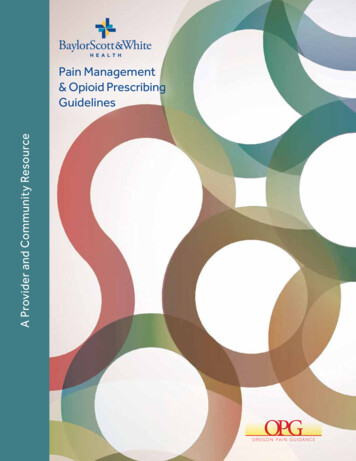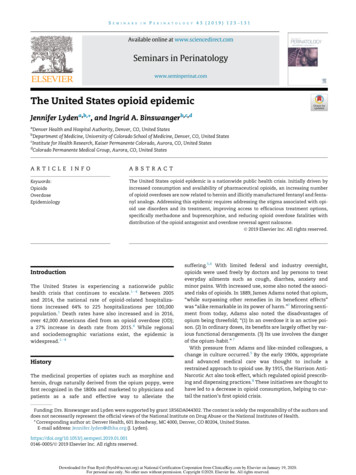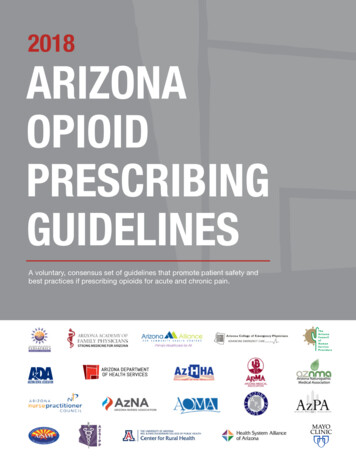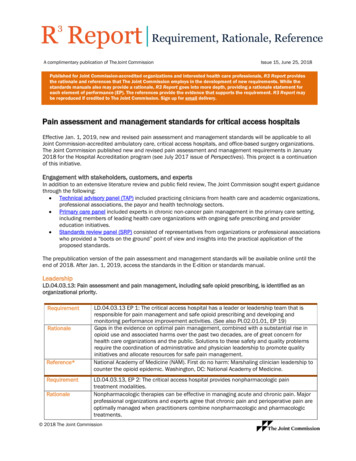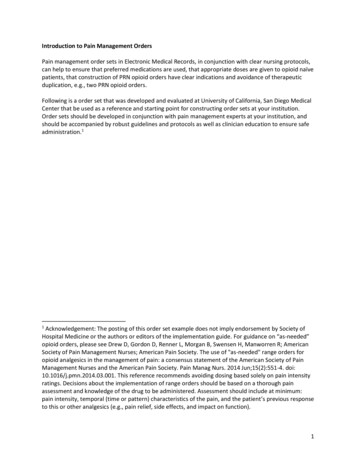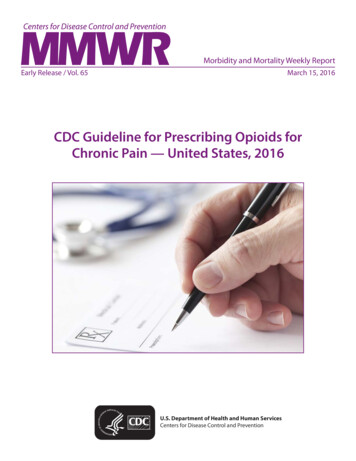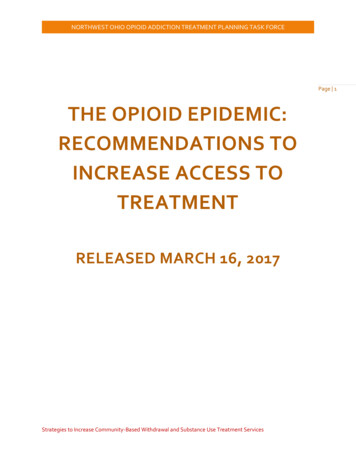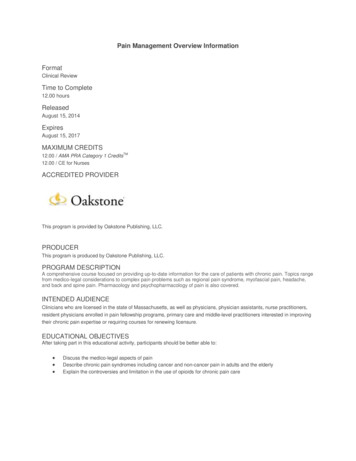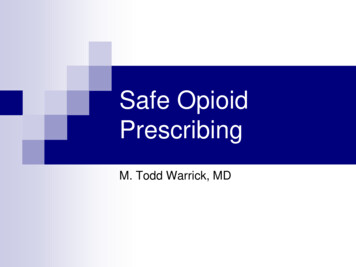
Transcription
Safe OpioidPrescribingM. Todd Warrick, MD
Learning ObjectivesImplement risk assessment tools whenprescribing chronic opioid therapy (COT) Utilize SCRIPTS (PMP) Approach to therapy initiation, titration,rotation, and discontinuation Monitoring tools such as drug testing Patient education Identify specific drug differences amongER/LA opioids
Overdose Death Rates (2008)
Opioid Prescribing by State (2012)
COT in Pain Management Commonly prescribed Limited evidence supports use for non-cancer painCOT goals Improveoverall quality of life Improve activity tolerance and physical function Decrease pain intensity Among the most abused medications Opioids, benzodiazepines, stimulantsSignificant risk from misuse and drug interaction
COT Risks Side effectsDrug interactionsTolerancePhysical DependencyInadvertent exposure, especially childrenMisuse / abuseAddictionDiversion by patient or family / householdRespiratory DepressionOverdose and Death
Opioid Side Effects / Management OptionsNausea and vomitingAnti-emeticsOpioid RotationSedationLower dose (if possible);Add nonsedating co-analgesicAdd stimulant or attention enhancerConstipationStool softeners, osmotics, diet changesRelistor, Amitiza, MovantikItchingAntihistamines (low efficacy), A / A rotationEndocrine dysfunctionReduced libidoLoss of menstrual periodEndocrine monitoringTestosterone replacementEndocrine consultationEdema and sweatingOpioid RotationDizzinessAntivertigo agentsConfusionLower dose, rotate opioid
Opioid Interactions CNS depressants Partial agonists, agonist/antagonist analgesics buprenorphine, pentazocine, nalbuphine, butorphanolMay reduce analgesic effect or precipitate withdrawal symptomsSkeletal muscle relaxants alcohol, sedatives, hypnotics, tranquilizers, TCAs, MAOIsrespiratory depression, hypotension, profound sedation, orcoma, serotonin syndromeIncreased respiratory depressionAnticholinergic agents Increased risk of urinary retention and severe constipation,which may lead to paralytic ileus
Other InteractionsMedicationAZTMethadoneIncrease in AZT concentrations; possibleAZT toxicityBuprenorphineNoneLopinavir/Ritonavir Opiate withdrawal may occurNoneRifampinOpiate withdrawal may occurOpiate withdrawal may occurFluconazoleIncreased methadone plasma concentrationsCiprofloxacinIncreased methadone plasma concentrationsSertralineNoneDuloxetinePotentially increases duloxetine exposureDextromethorphanAssociated with deliriumAripiprazoleNoneNoneCarbamazepineOpiate withdrawal may occurNot studiedMethylphenidateNoneNoneDiphenhydramineMay have synergistic depressant effectNone
Risk Factors for RD/ODGenerally preceded by sedation anddecreased respiratory rate Risk factors for Respiratory Depression OSA,morbid obesity, snoring Age ( 60) CNS depressant polypharmacy Cardiopulmonary disease, organ failure Smoking Post-Surgery – upper abdominal and thoracic
Aberrant Use Definitions Misuse - using a medication in a manner otherthan as specifically directed by a healthcareprofessional Self titration due to poor pain control or anxietyAbuse – deliberate nonmedical use Crushing,snorting, injecting Diversion (buying/selling/stealing) Both contribute to opioid-related deaths
Definitions (continued) Tolerance - adaptive state after drug exposure,increased dose required for clinical effect Dependency – physiological adaptation whereindiscontinuation or reversal of drug causes withdrawalsyndrome Alone, does not indicate addictionOccurs in all patients on sufficient doses over timeAlone is not indicative of addictionAddiction – primary, chronic, neurobiological diseasewith genetic, environmental, and psychosocial elements One or more of the following Impaired control over use, compulsive use, continued usedespite harm, craving
Opioid Tolerance According to the FDA, a patient isconsidered opioid tolerant if they aretaking, for one week or longer, at least:(po) – 60 mg/day Hydrocodone – 60 mg/day Oxycodone – 30 mg/day Fentanyl (td) – 25 mcg/h Hydromorphone - 8 mg/day Oxymorphone – 25 mg/ day Morphine
Risk Factors for Misuse/Abuse Personal history of substance abuse Prescriptiondrugs illicit drugs EtOHFamily History of substance abuse Age 16 – 45 Psychiatric Comorbidity BPAD, ADHD, GAD, MDD, personality d/oPreadolescent sexual abuse in women
Risk Stratification Tools Use prior to opioid initiation Opioid Risk Tool (ORT) www.partnersagainstpain.com Screener and Opioid Assessment forPatients with Pain (SOAPP) www.painEDU.org
Opioid Risk Tool (ORT)CATEGORYRISK FACTORFEMALEMALEFamily History ofSubstance AbuseAlcoholIllegal DrugsPrescription Drugs124334Personal History ofSubstance AbuseAlcoholIllegal DrugsPrescription Drugs345345AgeAge 16-45 years11History of Preadolescent Sexual Abuse30Psychological Disease2211ADHD, OCD,BPAD,SchizophreniaDepressionTotal Risk ScoreTotal Score Risk CategoryLow Risk 0–3Moderate Risk 4–7High Risk 8
Opioid Risk Tool (ORT) Low Risk Moderate Risk No past or current substance abuseNoncontributory family historyPsychologically stableHistory of substance abuse, long-term recoveryConcerning family historyComorbid psychiatric conditionHigh Risk Active Substance abuse / addictionMajor untreated / unstable psychiatric conditionSignificant risk to self and prescriber
COT Initiation Step 1: Take a history Pain/ Symptom history Onset, character, duration, severity, relieving/exacerbating factorsPrior workup, diagnoses, tests, treatments, surgeriesSubstance use history, family substance use history Parental addiction is the #1 risk factor for patient addictionPsychiatric HistoryWork History / Disability
COT Initiation Physical Exam Multi-organsystemMusculoskeletal, neurological Waddell signs Tenderness not related to a particular skeletal orneuromuscular structure; may be either superficial ornonanatomic. Superficial – The skin in the lumbar region is tender tolight pinch over a wide area not associated with thedistribution of the posterior primary ramus. Nonanatomic – Deep tenderness, which is not localizedto one structure, is felt over a wide area and oftenextends to the thoracic spine, sacrum or pelvis.
PE: Waddell Signs (contd) Simulation Tests - These tests give the patientthe impression that a particular examination isbeing carried out when in fact it is not. Axial Loading – Low back pain is reported whenthe examiner presses down on the top of thepatient’s head Rotation – Back pain is reported when theshoulders an pelvis are passively rotated in thesame plane as the patient stands relaxed withthe feet together
PE: Waddell Signs (contd) Distraction Test - A positive physical finding isdemonstrated in the routine manner, and this finding isthen checked while the patient’s attention is distracted; anonorganic component may be present if the findingdisappears when the patient is distracted. Straight Leg Raising – The examiner lifts the patient’sfoot as when testing the plantar reflex in the sittingposition; a nonorganic component may be present if theleg is lifted higher than when tested in the supineposition.
PE: Waddell Signs (contd) Regional Disturbances - Dysfunction (eg,sensory, motor) involving a widespread region ofbody parts in a manner that cannot be explainedbased on anatomy; care must be taken todistinguish from multiple nerve root involvement.– Demonstrated on testing by a partialcogwheel “giving way” of many muscle groups thatcannot be explained on a localized neurological basis. Sensory – Include diminished sensation to light touch,pinprick or other neurological tests fitting a “stocking”rather than a dermatomal pattern. Weakness
PE: Waddell Signs (contd) Overreaction (pain behaviors) - May takethe form of disproportional verbalization,facial expression, muscle tension andtremor, collapsing, or sweating; judgmentsshould be made with caution, minimizingthe examiner’s own emotional reaction.
COT Initiation Prior to initiation, discuss/document: Goalsof therapyModerate pain reduction - 30-50% Objective functional goals Risksand BenefitsDependency is not a risk, it is a virtual absolute Side effects, drug / EtOH interactions Impairment – work, driving Risk stratification, potential for aberrancy StartLow and Go Slow
Drug Initiation Start low-potency, short-acting, PRN ER/LAformulations are inappropriate for COTinitiation and most should only be consideredfor opioid tolerant patients. Follow-up frequently with patients 1-2weeks until stableFewer pills dispensed, fewer to discard ifineffective or side effects preclude use Monitor compliance and effectiveness
Controlled Substance Agreement Informed consent treatment “contract” Risks/benefits/alternatives to COT Outlines prescriber expectations of patient Single pharmacy / single prescriber Patient accountability to safeguard medication No selling or sharing of medication with othersTake ONLY as prescribed, no self-titration No refills for lost/stolen/destroyed medicationKeep out of reach of children, elderly, etcNo early refills or nights, weekends, holidaysConsent to toxicology testing and pill-countsRefills are contingent upon keeping scheduled appointmentsRefill requests and appointment rescheduling: 3 days notice24 hour wait time for Rx refillsPrivacy waved in the event of law enforcement involvementTherapy may be discontinued at any time for misuse, lack ofefficacy, risk benefit, noncompliance with terms.
Opioid Management / Monitoring The 4 A’s Analgesia Numerical or Subjective Activity levelWork duties, exercise, domestic chores, leisure Adverse Side effects, affect / personality, family dynamics Aberrant reactions / effectsbehaviorsMisuse/Abuse/Diversion
Other Monitoring Tools Current Opioid Misuse Measure (COMM) 17questions of issues over last 30 days 0 Never, 4 Very OftenThinking, memory, task completion Obsessive thoughts, anger, anxiety, self-harm Misuse, diversion, drug seeking, ER visits NPV for opioid misuse 0.95% www.painEDU.org
Drug Testing Saliva, Urine and Blood Urine Point of Care cups, GCMS confirmationPOC has substantial false (-) and ( )GCMS is very accurate Saliva testingTakes about 5 minutes to saturate swabNo POC, may be more convenient or low-risk patients ForPOC( ) results, consider waiting for confirmationbefore making major management decisions Know your metabolites for proper interpretation Codeine to Morphine, OC to OM, HC to HMParent drug vs metabolite presence, detection window
Prescription Monitoring Program SCRIPTS South Carolina Reporting & Identification Prescription Tracking System Createdin 2006 (H.3803), started 2008 Exclusions Inpatient pharmacies 48 hour supply dispensed from hospital ER Dispensings to long-term care facility residents Five day supply (or 31 days of phenobarb) by a vet FEDERAL DISPENSERS VA / military base pharmacies Methadone clinics
SCRIPTS Sample Report
Prescription Monitoring Program 2014 S.840– signed by Gov Haley 6/6/14Daily data submission from dispensers Delegate authorization Individual supervised by authorized prescriber or pharmCriminal penalty for delegate use violations Felony – fine 10k, or prison 10 yearsDisciplinary board action for practitioner violations 2 hr prescribing CME per biannual license period Mandatory use was REMOVED from the bill
PDAP Council Gov Haley executive order 3/14/2014 Inresponse to SCOIG 5/2013 outlining thegrowing Rx drug abuse problem in SC andthe lack of statewide strategy 10 members SLED,DHEC, LLR, DHHS, DAODAS,Solicitor’s Office Boards of Medical Examiners, Nursing,Pharmacy, Dentistry Physician advisors in pain management,emergency medicine, family practice
PDAP Council – Joint PM GuideMANDATORY PMP UTILIZATION perJoint Revised Pain ManagementGuidelines MED 80 3 months RED FLAG Re-establish informed consent, review functional status including daily activities,analgesia, aberrant behavior and adverse effects as it relates to progress towardtreatment objectives established at the onset of opioid therapy; consult SCRIPTSto verify compliance; re-establish office visit intervals’ review frequency of drugscreens; and review and execute a new treatment agreement. Relevantinformation from SCRIPTS should become part of the patient’s medial record. Avoid dose escalation without attention to risks and alternativesComplete eradication of pain is not an attainable goal “Reasonable level of discomfort” is the best clinical outcome apatient may receive
PDAP Council – Joint PM Guide Pain management in the ER UtilizeSCRIPTS Consult with patient’s opioid prescriber Rx for chronic pain is only rarely indicated inthe ER and should limited to supply sufficientfor patient to see primary provider No replacement Rx for lost/stolen/destroyed ER/LA opioid should not be routinely Rx Acute pain Rx should rarely exceed 5 daysUse SCRIPTS Screen for substance abuse prior to Rx whenappropriate
Opioids -Titrate, Rotate, Convert? Opioid management frequently requiresdose or drug changes to balance efficacy,tolerability, compliance and risk Shortvs Long-Acting opioids Abuse Deterrent Formulations (cost / benefit) Breakthrough pain QHS dosing (sleep apnea) Limited formulary options for CMS, Tricare Poor evidence-based management data
Drug Diversion – Warning Signs Suspicious History Patientreferred already taking controlledsubstances, especially opioid/relaxer/sed Vicosomaxanax / Percosomaxanax Soft diagnosis based on symptomsCOT often contraindicated in FMS, IBS, chronic dailyheadache, interstitial cystitis, chronic pelvic pain Multipledoctors / prescribers The Out-of-Towner Limited / unobtainable old records from referring doc Old, tattered, suspicious records (ash tray smell) Request for specific drug
Drug Diversion – Warning Signs Suspicious Physical Exam Normalexam, exaggerated exam, Waddell Symptoms out of proportion to objective findings Severe weakness with normal reflexesSevere numbness with normal Babinski PoorDentition (meth mouth) Arm scars (skin popping / track marks) Red eyes / nares Smoke smell, “Legalize It” T-shirt, etc.
COT Discontinuation Reasons Lack of objective improvement in physical, functional, andpsychosocial activitiesCompliance issuesIntoleranceDiscontinuation of COT is not patient abandonment butshould NOT mark the end of treatment through othermodalities or referral to specialists (pain, addiction)Structured wean is often safe and effective Reduce dose 30-50% every 3-5 days, 14 days rarely necessaryIncreased pain is most common complaintOpioid W/D is NOT associated with DTRapid discontinuation is NOT life threateningConsider inpatient detox and outpatient recovery program
Further Information ER/LA REMS program (3 hours CME) Indepth instruction on long-acting opioidprescribing / management Bibliography Lotsof links to cited documents and onlineresources for further reading
Questions?
COT in Pain Management Commonly prescribed Limited evidence supports use for non-cancer pain COT goals Improve overall quality of life Improve activity tolerance and physical function Decrease pain intensity Among the most abused medications Opioids, benzodiazepines, stimulants Significant risk from misuse and drug interaction


